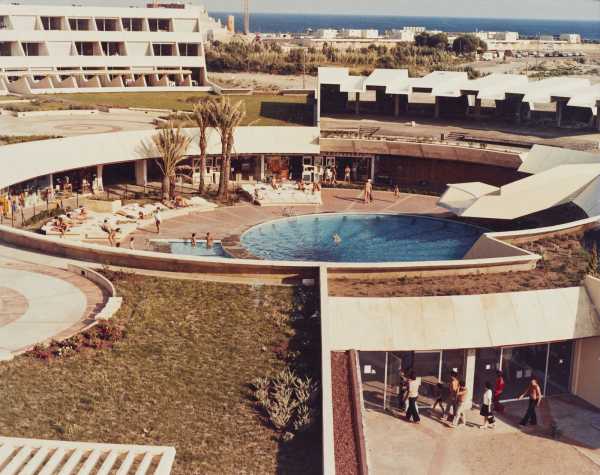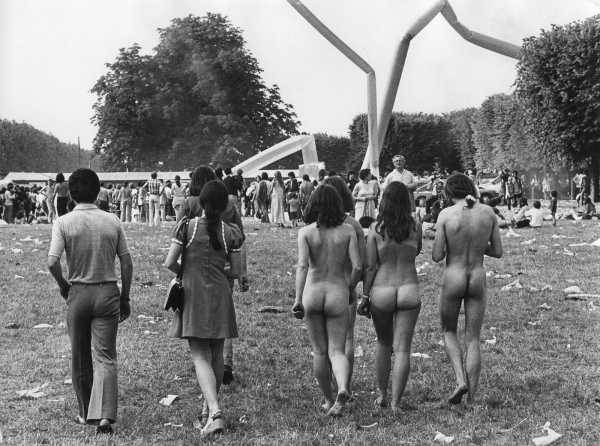
Save this storySave this storySave this storySave this story
Marseille’s Museum of European and Mediterranean Civilizations (Mucem) is a lattice-shrouded, shadow-throwing complex that juts over the waters of the city’s old port. Despite the seaside vibe, its code of conduct states that “perfect correctness, particularly in dress, is demanded of visitors; it is for example forbidden to walk around shirtless or barefoot.” Yet, on a recent afternoon, as a man strode across the entrance hall in nothing but a floral pareo and a lanyard—i.e., shirtless and barefoot—no one seemed bothered in the slightest. The museum, which was closed to the general public for the day, was offering a special tour of its big summer exhibition, “Paradis Naturistes” (“Naturist Paradises”). In keeping with the show’s theme, guests, such as the man in the lobby, would be allowed to shed their clothes, store them, and stroll through the galleries naked.
The museum was hosting the event in conjunction with the Fédération Française de Naturisme, which has represented the interests of naturists in France since 1950. Today, they number about 4.7 million—including the two and a half million who visit the country each year, making France Europe’s No. 1 destination for naturist tourism. A note about vocabulary: naturism, per the F.F.N., refers to “a manner of living in harmony with nature, characterized by the practice of communal nudity, and which consequently fosters self-respect, respect for others, and respect for the environment.” You can be a nudist without being a naturist, in other words, but you can’t be a naturist without being a nudist.
Why, one might ask, would a person be either? Naturists insist that public nudity—exposing oneself not only to others but to sun, air, sand, and sky—yields a range of benefits, from body acceptance to class erasure. “Behind it, there’s an ideology of equality that is very French,” Eric Stefanut, the man in the pareo and the F.F.N.’s communications director, told me, as he cooled himself with a white paper fan. “When someone is naked, you don’t know whether he’s a sales director or a mason. Nudity makes social difference invisible—it puts everyone on the same level.”
It’s also a way of experiencing familiar things in a novel manner. Recently, chapters of the F.F.N. have sponsored naked bike rides, naked camping trips, naked volleyball matches, naked pétanque, naked gardening, and a naked visit to a sewing-needle factory. Pretty much anything you can do dressed, naturists contend, you can do naked. (See the naked hikers of the Hautes-Alpes, trudging through passes of the Massif du Dévoluy in their snowshoes.) In July, the Association des Naturistes de Paris advertised a naked cocktail party, promising a spread of “charcuterie boards, cheese boards, whitefish rillettes with dill, candied cedar lemon hummus, peanut brownie, red fruit panna cotta, etc.” I couldn’t help being amused by their focus on the menu. In certain ways, it turns out, naked French people are a lot like clothed ones.
Traditionally, French naturists have been largely white, heterosexual, and left-leaning, “with teachers and professors particularly well represented,” as Stephen L. Harp observes in “Au Naturel: Naturism, Nudism, and Tourism in Twentieth-Century France.” Picture a married couple, Thierry and Sandrine, retired school principals who protested in ’68 and haven’t had a tan line in half a century. Particularly since COVID, though, the practice has been attracting a different set. According to the F.F.N., forty-three per cent of French naturists are under thirty years old. “The movement is getting younger and surfing the organic wave,” Le Parisien reported recently, while Le Progrès declared naturism “all the rage” for its “de-stressing” qualities. Even among textiles, as naturists call the clothes-wearing population, nakedness is having a moment. France 5 is airing the twelfth season of “Nus et Culottés” (“Naked and Cheeky”), a popular show in which a pair of friends set out pantsless and penniless on various adventures. And who can forget Philippe Katerine in the opening ceremony of the Olympics, crooning “Nu” (“Naked”) while sprawled across a fruit platter in bright-blue body paint? “Would there be wars if we were all naked?” Katerine sang. “Where do you hide a gun when you’re naked?”
Stefanut led me to a folding table, where the F.F.N. was offering cups of water, potato chips, gummy bears, and informational literature. One brochure tackled prejudices surrounding naturism, such as the idea that it’s dirty. “The self-respecting naturist NEVER goes out without a pareo or a little towel” to protect his posterior from any surface he sits on, the brochure explained. “And if I get an erection?” it continued. “Zero risk! Permanent nudity desexualizes your thoughts. The real question for men is more often, ‘Is it going to work again?’ ” A corollary to the precept that naturism is not inherently sexual holds that naturism is a family-friendly activity. The gallery tour cost eleven euros, but visitors under the age of eighteen could attend for free.
About eighty people, nearly all adults, had shown up for the tour. Each one was given a numbered tag and a yellow plastic bag before being shown to a storage room where they could disrobe. In the visitors went. Out they came, in coverups that would shield their genitals from civilian eyes—or, rather, shield civilian eyes from their genitals—until they crossed the museum floor to enter the exhibit.

A photo of a naturist resort in Port Ambonne, circa 1970, featured in the Mucem exhibition this summer.Photograph by Marie-Hélène Oltra / Courtesy Mucem
“Naturist Paradises” features more than six hundred photographs, films, magazines, paintings, sculptures, drawings, maps, and artifacts, many of which have been borrowed from personal archives and are being shown for the first time. The show arose not just because of the surging popularity of naturism but because of Mucem’s proximity to environments that facilitate it. “The southern coasts, particularly the shores of the Mediterranean, attract those who are looking for unspoiled natural spaces to free their bodies from all forms of constraint,” Amélie Lavin, one of the show’s four co-curators, explains in a handsome catalogue. The exhibition is divided into three sections: the origins of naturism, naturist communities, and the future of the movement. In a cheerful touch, some of the displays are set off with the kind of wooden barriers commonly used to protect sand dunes. The day I was there, visitors repurposed one as a rack for their last shreds of clothing, tossing underpants over the rails as though they’d just gone for a dip.
Naturism originated around the turn of the twentieth century, in northern Europe. Utopian movements such as Germany’s Lebensreform promoted such practices as vegetarianism, temperance, organic farming, sunbathing, and naked outdoor gymnastics as correctives to the ills of a rapidly industrializing society. During the First World War, collective nudity was said to strengthen morale among troops. One striking photograph, discovered in a family album, shows a group of German soldiers sitting in a semicircle, playing cards in the buff. “One can imagine that the hierarchy encouraged this genre of display, as these well-nourished bodies wouldn’t fail to reassure the soldiers’ parents of their dazzling health,” Gérard Amaudric writes in the catalogue. Going naked, he argues, offered a “small flame of hope, that of a new world without any uniform.”
In the aftermath of a war that ravaged millions of bodies, French medical authorities sought new methods of promoting health and healing. The naturist doctors Gaston and André Durville developed a finicky diet regime and organized nearly nude beauty contests, popularizing the idea of a female figure that adhered to classical ideals. (“Too fat, fat hips, oversized breasts, fat stomach, not muscular enough, skin too pale, legs and fat non-symmetrical buttocks,” Gaston noted, of one entrant.) According to the nudist writer Marcel Kienné de Mongeot, moral defects manifested in the body, and improving one’s physique was a means of uplifting the French nation. Some early proponents of naturism dabbled in eugenics and race science as their followers “played primitive,” Harp writes, without “suggest[ing] that indigenous peoples were equal or should be anything more than imperial subjects.”
In the nineteen-fifties and sixties, naturism came to be associated less with medicine than with pleasure. At fashionable beaches like Pampelonne, women went topless and culs nus (“naked butts”) staked claims on prime stretches of sand, sometimes provoking conflicts with officials such as the humorless cop played by Louis de Funès in “Le Gendarme de Saint-Tropez.” As nude sunbathing entered the mainstream, naturists became more assertive. One scandalized vacationer reported that clothed interlopers at a beach in the Var were greeted with shouts of “À poil, les voyeurs!” (“Get naked, voyeurs!”) Turf battles between naturists and textiles continue: this summer, near Marseille, a gay man reported that he was attacked and insulted with homophobic slurs after swimming at a nude beach and returning to a nearby village in a Speedo-type bathing suit. “Put your clothes back on!” his aggressor yelled. “There are kids here!”
The Mucem exhibit focusses on seven iconic sites of French naturism, including the Île du Levant, a quirky island enclave known for a loincloth-like garment called le minimum, and Cap d’Agde, a planned city built by the state as part of a program to develop the neglected economies of the southern coast. Cap d’Agde started out as a mosquito-ridden campsite. By the late nineteen-seventies, it boasted a brutalist apartment complex designed by Jean Le Couteur, a marina, and a shopping center with butchers, bakers, a cinema, a night club, and, somewhat puzzlingly, several clothing boutiques. One photo, part of a series by Laurent Sola, shows a naked woman sitting under a hair dryer, flicking through a magazine. In later decades, Cap d’Agde was largely taken over by sex tourists, offering an interesting test case for the tenet that naturism has nothing to do with sexuality. Tensions ran so high that in 2008, when three night clubs burned to the ground, investigators suggested that old-school naturists might be to blame.
The nostalgic, scrapbooky feel of “Naturist Paradises” is touching, and largely successful, but it leaves certain people and issues lurking outside the frame. I would have liked to learn more, for instance, about naturism’s opponents, from the priests who lobbied officials to ban naturist publications from kiosks to the prison inmate who reportedly threatened a terrorist attack on Cap d’Agde because he “didn’t like les culs nus.” The catalogue devotes some thought to the relationship between naturism and colonialism, but the show mostly neglects to examine it, nor does it grapple with the whiteness of the naturist milieu, especially in a city as racially diverse as Marseille. With all the focus on the joys of being naked, I would also have welcomed an acknowledgment of the ways that nudity can be used to degrade and humiliate, from Abu Ghraib to upskirting and A.I. porn fakes. What’s paradise without a few snakes?

A socialist gathering in 1973.Photograph by Laurence Brun / Gamma-Rapho / Courtesy Mucem
You wouldn’t believe how hard it is to figure out what to wear to a nude museum tour. Eventually, I settled on black jeans and a tobacco-colored poplin blouse, which, as a journalist and a textile, I was not obliged to take off. It wasn’t that I didn’t get the appeal of naturism—who hasn’t wanted to rip off a wet bathing suit and lie on a warm rock, like a seal?—but what might be appealing on a sun-kissed beach seemed less so in an air-conditioned gallery.
Before the doors opened, I had got to talking to a couple in their twenties. They told me they’d started going naked with friends while living in Berlin. Rather than joining an organization, they preferred to operate in “a free, autonomous manner,” and they seemed slightly skeptical of the need to label and federate the perfectly obvious pleasure of liberating oneself from constricting collars and chafing bras. What their elders called naturism they called going to a summer picnic or attending a “queer-techno night,” where nobody needs a membership card to peel off their shirt. “Being naked makes us feel a little more free,” one of them said.
Being naked, she added, felt like “a way to recapture privacy.” Initially, I was surprised by this—what could be less private than dropping trou in a crowd? But it makes sense: naturist gatherings are one of the few remaining places where no one takes pictures without the express permission of their subjects. Even without a camera, checking people out is considered the height of bad manners. “We look each other in the eye,” Stefanut told me. “Nudity generates mutual vulnerability, and out of that is born a form of respect, where I take care of you and you take care of me. It’s the opposite of what people imagine.”
The lighting in the gallery was low. A guide was showing the visitors around, but they were free to roam at their own pace. Reading about naturism in advance of my trip, I had come across a debate about physical beauty between the Durville brothers and one of their friends. “From the aesthetic point of view, what is uglier than a man with sagging testicles?” the friend wrote. I wasn’t sure I wanted to find out.
Yet here I was, surrounded by convex bums, billowing bat wings, skin tags, stray hairs, third nipples, breasts melting like Dalí’s clocks. Everyone had kept their shoes on, and one woman was wearing a coral-colored pair of block heels, which I found fascinating. Another man had tossed a scarf around his neck, which, had pictures been allowed, might have gone viral as The Most French Thing Ever. As I stood there in my clothes, interviewing naked people, my prevailing sensation was not revulsion but regret. Amid all the trust and vulnerability, I felt like a narc.
À poil, then! Since I didn’t have a coverup, I undressed in the changing room and put on a borrowed F.F.N. volunteer vest, turning it around so that it covered the front side of my body, and shuffled back to the gallery, like a basketball player performing a lateral quickness drill, so as not to show my butt. Now that I, too, was naked, I was a little less agog at other people’s bodies and a little more conscious of my own. (Forget Pilates: there is no better way to improve your posture than stripping down in a room full of strangers.) Even so, I didn’t feel overly awkward, except when I tried to jot down a quote about how naturists are now as interested in mental health as they are in physical fitness, and, thanks to the unfortunate placement of my notebook, found myself staring directly at my interlocutor’s penis. Still, the team spirit was contagious. “I feel like a stain,” a clothed security guard told me, admitting that he might have joined in if he’d been allowed.
Later, at my hotel, I sorted my notes and read through the rest of the literature I’d picked up. Is it dangerous to expose your private parts to the sun? No. Just use sunscreen. Are tattoos O.K.? They used to be looked down upon, but naturism has evolved along with society. (Despite all the talk about body acceptance, naturists are cool on genital piercings, “which draw the eye to that part of the anatomy.”) What do women do during their periods? Those who use tampons “snip the string for style, or fold it up,” while those who use pads wear a bathing-suit bottom. Perhaps the wildest thing about getting as naked as the day you were born is that it has to be taught. ♦

Nudists at a filling station in Cap d’Agde.Photograph by Laurent Sola / Gamma-Rapho / Courtesy Mucem
Sourse: newyorker.com